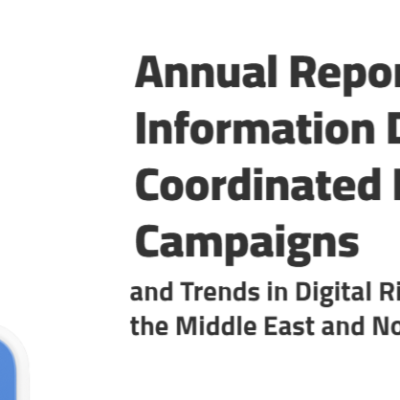Syria in Transition: Mapping Conspiracy Theorists on Social Media
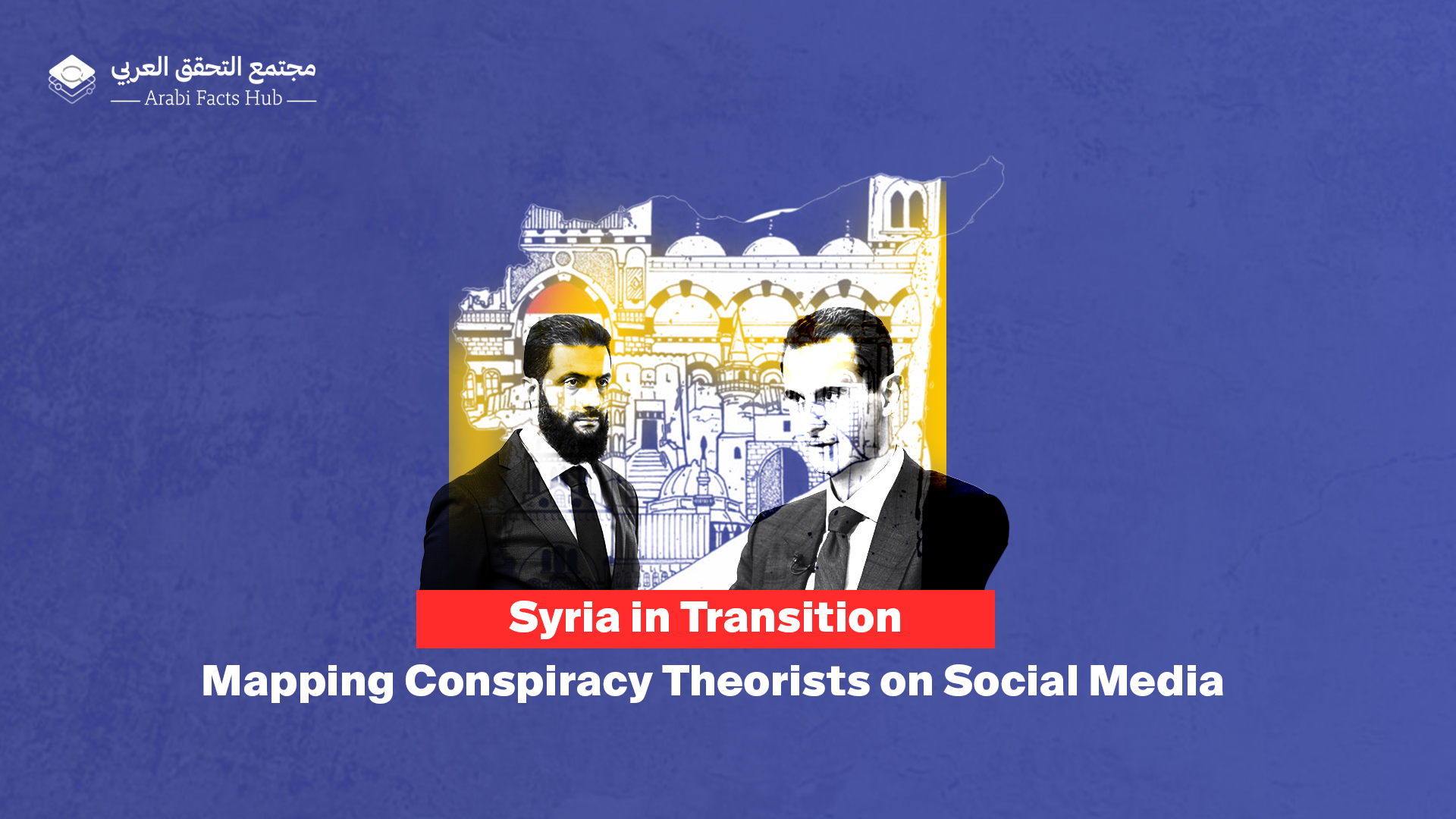
On December 8, 2024, the authoritarian regime of Bashar Al-Assad collapsed. Thirteen years since the start of the Syrian revolution, and after so much death, displacement, and destruction, rebel forces led by Hay'at Tahrir al-Sham breezed into Damascus, culminating a lightning-fast offensive that had begun merely a few weeks earlier. So long beneath the iron boot of the Assad dynasty, Syria finds itself suddenly, unthinkably, in transition.
While this transition represents a hopeful moment during which Syrians may be able to define a just and peaceful future for themselves, it is also a time of uncertainty and chaos during which disinformation and foreign interference may thrive. Domestic media outlets that had until the penultimate moment acted as megaphones for Assad’s propaganda, must now choose if and how to redefine themselves under the transitional government. Foreign apologists for the Assad regime, shocked by its collapse, must decide whether to embrace transition or rail against it. Foreign governments seeking to influence the course of transition must decide how their regional media outlets should cover the transition. Under such fluid circumstances, not only lies, but merely the prioritization of certain truths over others, could have material consequences for the stability of the transitional government, and the trajectory of Syria’s future.
Narratives
On January 30, 2025, the Tahrir Institute for Middle East Policy published an excellent article offering a qualitative overview of several variants of disinformation that have emerged during this transitional period for Syria. In so doing, the article identifies certain topics that are being seized upon by conspiracy theorists. Some of these are more domestic in nature – fraudulent financial scams hoping to snare unsuspecting Syrians, or malicious disinformation regarding political prisoners freed from Assad’s notorious prisons. Other narratives, however, are ripe for manipulation by foreign actors.
Firstly, the Assad regime was no different from many authoritarian regimes across the Middle East and North Africa insofar as it complemented its brutal repression of the majority with the coddling of certain minorities, most notably Syrian Alawites. In the wake of the regime’s collapse, a natural fear is that minorities that benefited from the regime may face persecution under a new majoritarian government. Indeed, in Egypt after the fall of Mubarak in 2011, and with the democratic election in 2012 of the Morsi administration, fears that Egypt’s Christian minority would be persecuted under the new Islamist government contributed to momentum that ultimately culminated in a counterrevolution and the restoration of military dictatorship in 2013. To be clear, concern for the welfare of minorities in Syria, Egypt, or elsewhere, is completely valid, as are fears that those minorities may face retribution for their complicity in authoritarianism, and likewise fears that they may be the target of sectarian hatred and violence in a post-revolutionary security vacuum. That said, it would match a longstanding pattern in the Middle East if such valid concerns over the treatment of minorities were artificially amplified and exacerbated by domestic elements of the ancien régime, and their foreign backers, as a premise for counterrevolutionary action. Thus, while persecution of minorities is not in and of itself a disinformation narrative, it is fertile ground for the growth of conspiracy theories.
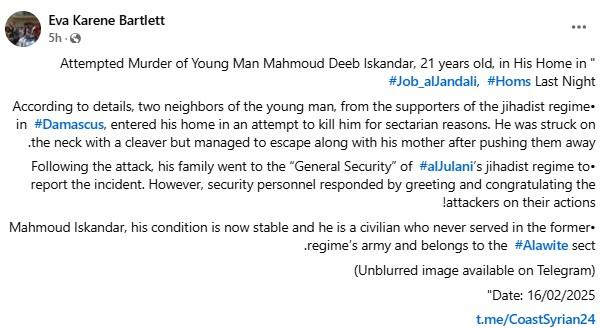
Figure 1: A Facebook post by Eva Karene Bartlett, dated February 16, 2024, alleging the attempted murder of a young man from the Alawite sect, and the subsequent indifference of Syria’s transitional authorities. The post references the Telegram channel CoastSyrian24, whose feed is rife with alleged incidents of sectarian violence and chaos.
Secondly, the timing of Assad’s overthrow inevitably raises questions about whether or to what degree the transitional government in Damascus is independent of foreign interests. Since the start of the Syrian civil war in 2011, it is no secret that the Assad regime managed to stave off the rebels by leveraging its alliances with Russia, Iran, and Lebanese Hezbollah. For several years now, however, Russia’s military capacities have become importantly tied up by the Ukraine invasion. And in 2024, both Iran and Hezbollah were drawn into war with Israel over the genocide of Gaza. Hezbollah’s military capacities were substantially destroyed during Israel’s brief but destructive invasion of Lebanon, while Iran has been largely deterred from further conflict with Israel after a series of violent exchanges. With Assad’s allies in disarray, it makes perfect sense that the Syrian rebels seized the opportunity to launch their offensive against Damascus. But as a consequence, their victory is not independent of these external events. In particular, while the rebels may have been merely opportunistic in launching their offensive against Assad in the wake of Hezbollah’s defeat in Lebanon, it is easy to see how conspiracy theorists will allege that the offensive was not merely opportunistic of Israel’s invasion of Lebanon but actually coordinated with Israel.
This conspiracy theory gains further momentum when considering the immediate aftermath of the rebel offensive. Having just melted away before the advance of the rebels, what remained of the Syrian army was promptly bombed by Israel in mid-December. Thus, in the space of just a few weeks, the Syrian army came under fire from both rebels and the Israeli air force – a convergence that invites conspiracy theorists to conclude that the two were coordinating. Israel also seized the opportunity to annex the Golan Heights and adjacent territory in Syria, and to all of this, the preoccupied transitional government in Damascus brooked no objection. While it may have been wise for the transitional government not to take a confrontational tack with Israel at this delicate moment, its failure to do so inevitably feeds into the view that they were coordinating behind the scenes.
Finally, the unintended consequences for the Palestinian resistance of the Syrian rebel offensive’s success add only more grist to the mill of conspiracy theorists. With Hezbollah and Syria subdued, the year-long crisis on Israel’s northern border was summarily ended, and the Israeli military could refocus all of its attention on Gaza and the West Bank. In short order, a ceasefire in Gaza was signed, suggesting that Hamas sued for peace once it realized it could no longer rely on the ‘Axis of Resistance’ for further support. From this point of view, the collapse of Assad’s regime can therefore be seen as a major blow to Palestinian resistance. As is common with conspiracy theories, intentionality is ascribed ex post after seeing who benefited from a turn of events. In this case, since Israel benefited from Assad’s defeat, conspiracy theorists conclude that Israel must have engineered it, and thus that the transitional government and Israel (and by extension, the United States) are all in league together.

Figure 2: A Facebook post by Eva Karene Bartlett, dated December 9, 2024, alleging the Syrian rebels are backed by the US and Israel, and that their ascendancy runs contrary to the interests of the Palestinian resistance. https://www.facebook.com/photo/?fbid=9198940363449209
Network mapping
While it is beyond our remit to fact-check any conspiracy theories or claims relating thereof, we believe it is helpful to readers to see the authors of such content against the backdrop of their broader social media network. The Tahrir Institute article draws on examples of disinformation content circulating on Telegram. Telegram is generally a wise choice for investigators seeking to gather an overview of disinformation narratives, since the platform’s lax content moderation policies mean that even the most problematic content is reliably preserved (see the example of CoastSyrian24 above). On the other hand, due to the platform’s design, a Telegram user is unlikely to encounter content of this nature unless they explicitly chose to subscribe to the relevant channels.
By contrast, Meta-owned platforms like Facebook and Instagram are arguably more dangerous vectors for disinformation. Despite their content being comparatively better policed, their model of algorithmic feed curation creates the possibility of incidental content encounters, putting disinformation in front of a wider and more unsuspecting audience. Facebook, for its part, is hugely popular in Syria, making it a sensible choice of platform for foreign actors seeking to influence thinking within Syria during the transition. Instagram, meanwhile, is not only the most natural next-generation platform to which Facebook users gravitate, but has also been a popular choice for Palestinian content creators documenting the Gaza genocide. As such, Instagram is a natural meeting place where pro-Assad conspiracy theorists connect with pro-Palestine influencers and related media outlets.
Whereas Telegram maintains a friendly third-party app ecosystem and a permissive API facilitating access to its data, Meta offers very limited API access to public interest researchers. To proceed, we developed our own scrapers for Facebook and Instagram to circumvent Meta’s restrictions and gather content authored by commentators on Syria. We began with a list of alleged Syria conspiracists identified in the image below.

Figure 3: Image listing media outlets and influencers that allegedly traffic in disinformation with regard to Syria. The image is credited to the Syria Mobilization Hub, and was posted to Facebook by Gail Vignola on January 30, 2025. https://www.facebook.com/share/18EwtwBQPM/
We scraped their Facebook content for the period October 1, 2024 - January 31, 2025, roughly covering two months preceding and following the fall of the Asad regime. We then processed their content to extract any examples of sharing activity, where they reposted content by others. We exploited this sharing activity to build a larger list of Facebook accounts, then scraped these as well. The resulting network map is displayed below.
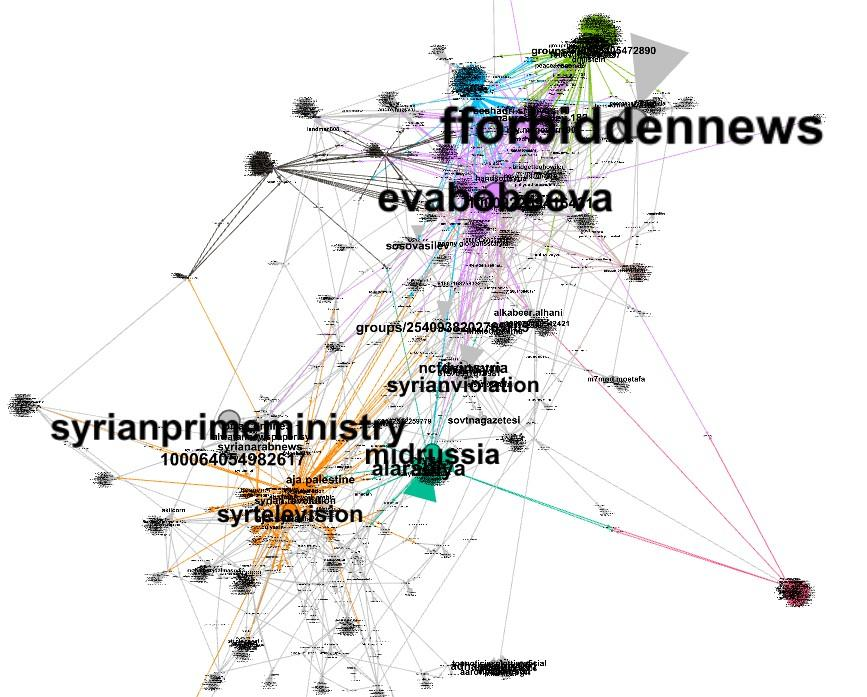
Figure 4: Facebook 1-hop engagement network map. Nodes correspond to Facebook pages and groups, while edges (lines) connect nodes whenever one node reshares the content of another. The nodes are positioned using the Louvain community detection algorithm, so that nodes appear closer together when they share similar content (and thus ideological overlap).
The network map displayed in Figure 4 displays distinct ideological superclusters with minimal modularity.
State news and the prime ministry
Towards the southwest of the map, there is a cluster surrounding the Syrian Prime Ministry’s Facebook page that includes the Syrian Interior Ministry’s Facebook page (moi.gov.sy), and the pages of Syrian state news outlets like Al-Watan (جريدة الوطن السورية) and SANA news (الوكالة العربية السورية للأنباء - سانا). Notably, these outlets operated as reliable organs of state propaganda throughout Assad’s tenure, and have attached themselves to the transitional government.
Revolutionary news
Further down, another cluster centers on syrtelevision (Syria TV تلفزيون سوريا), and includes many anti-Assad, pro-revolutionary news outlets favoring the rebel forces. In addition to Syria TV, these include syrian.revolution (شبكة الثورة السورية - Syrian Revolution Network), shaamnetwork.arabic (S.N.N | شبكة شام), as well as the Aljazeera affiliate accounts aja.syria (الجزيرة - سوريا) and aja.palestine (الجزيرة - فلسطين). Both Syria TV and S.N.N are based out of Turkey, while Aljazeera is of course based out of Qatar. We can conclude from their network positions that there is an alignment between Turkey, Qatar, and the revolutionaries.
Extending out of the revolutionary cluster are several journalists and digital creators that are likewise pro-revolution, including qu.yasin, tamer.turkmane, mohammadalmasry83, and mohammad.shehabi.31.
Russia/Saudi/UAE cluster
Closer to the center of the network, Saudi’s Al-Arabiya regional news outlet (alarabiya) appears co-clustered with Russia’s foreign ministry (midrussia) and Sky News Arabia (skynewsarabia). To be clear, we cannot confirm that any one of these three accounts shares the content of any other. Instead, their proximity in this network map owes to the activity of one Facebook account, vmatuzov (Вячеслав Николаевич Матузов), a political observer based in Moscow, formerly a higher-up in the Soviet Union focused on the Middle East. While it is telling that he shares content that favors the Russian, Saudi, and UAE positions, we should not read too much into the behavior of a single actor.
The conspiracy clusters
The most central cluster of the entire network map consists most prominently of syrianviolation, ncfdvinsyria, khaled.tuaima, alkabeer.alhani, Raymonda Hassan (100076186542421), and others. These accounts are pro-Assad. Notably, syrianviolation and ncfdvinsyria are both Facebook pages that were created after Assad’s collapse. Syrianviolation (المركز الوطني لتوثيق الإنتـ.هاكات في سوريا) was created on December 27, 2024, and has already amassed 112k followers. They also maintain a Telegram channel (https://t.me/syrainviolationscenter). Similarly, ncfdvinsyria (المركز الوطني لتوثيق الأنتهاكات في سوريا) was created on December 17, 2024, and has already acquired 261k followers. The page’s three administrators report their locations as Lebanon, Syria, and the UAE. They also maintain a Whatsapp channel (https://whatsapp.com/channel/0029Vb36oDu0bIdlQsmUqR1q).
Finally, in the north-northeast of the network, we find a denser concentration of networked conspiracy theorists. Most prominent among them is evabobeeva, the Facebook page of Eva Karene Bartlett, a Canadian-American journalist who has covered Syria and Palestine for the better part of two decades. Since the fall of Assad, evabobeeva has tended to post multiple times per day to her 59k followers. In between expressing outrage over the Gaza genocide and decrying alleged war crimes committed by Ukraine, she asserts that Syria has been taken over by sectarian terrorists, alleges various atrocities against minorities (especially the Alawites), and longs for Assad’s ‘pluralistic’ society.
Adjacent to evabobeeva is handsoffsyria, a Facebook page administered from Australia with 67k followers. The page also links to a website, https://www.handsoffsyria.org/, which publishes pro-Assad and conspiracist content. Since the fall of Assad, their Facebook feed has been rife with allegations of sectarian animosity visited upon minorities (usually Alawites) at the hands of the transitional government or associated militias. Their activity has gone so far as to provoke Meta’s content moderation policies.
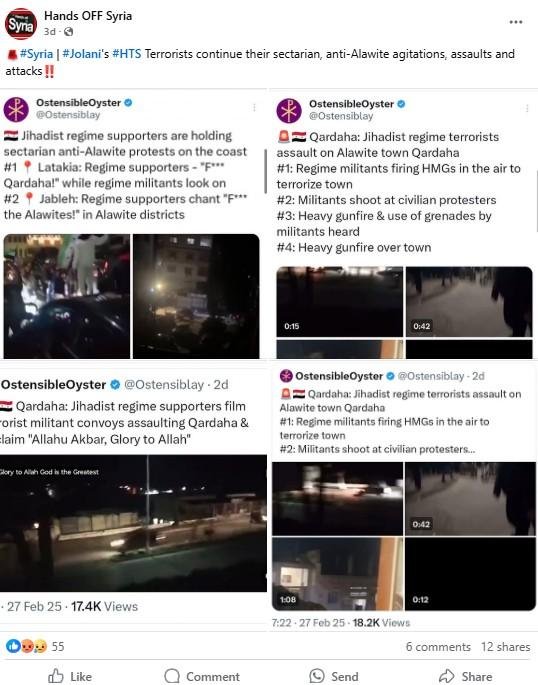
Figure 5: Facebook posts by handsoffsyria in early March, 2025, alleging (right) that Syria’s transitional authorities are persecuting Alawites, and (left) that they have pressured Meta to censor them for getting the truth out.
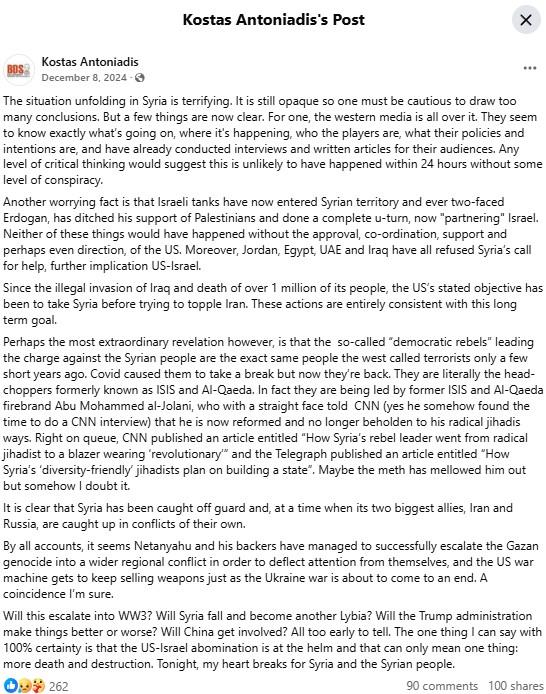
Figure 6: A popular Facebook post by kostasantoniou033 from December 8, 2024, that grapples with the fall of Assad.
Other accounts in the vicinity of evabobeeva include seshadri.srinivas.10, penny.giorgalisstafyla, karijaquesson, mintpressnews, kostasantoniou033. Among these, mintpressnews deserves special mention. Mint Press News is a pro-Assad, Russian-aligned, conspiratorial news outlet that has been reporting on Syria throughout the civil war (see their website at https://mintpressnews.com, and their Telegram channel at https://t.me/mintpress_news). If Mint Press News is to be believed, the White Helmets are a militant organization and there is no evidence that Assad used chemical weapons against his own people. Its Facebook page, mintpressnews, has 446k followers as of the time of writing, making it a mainstay of the conspiracy network.
Reviewing some of its posts from late December, MintPressNews has nothing positive to say about the fall of Assad.


Figure 6: MintPressNews posts following the collapse of the Assad regime are consistently negative, delegitimizing the transitional government by dwelling on its past affiliations and insinuating its alliance with the US humanitarian outreach.
The Palestine Intersection
Prominent pro-Assad, anti-transitional accounts like evabobeeva and mintpressnews share one common feature: they are aghast at the genocide of Gaza and sympathetic to the plight of the Palestinians. This is no coincidence, but the causality runs both directions. In one direction, people who begin by supporting Assad seize upon Palestine opportunistically to situate Assad in a favorable light, as a champion of the Palestinian cause. Their interest in Palestine is secondary to their interest in Syria.
In the other direction, however, there are characters like Eva Karene Bartlett, whose first encounter with the region appears to be Palestine, not Syria. The moral disaster that they witness in Palestine erodes their faith in the Western governments and media that enable it. From this erosion emerges a concomitant enthusiasm for embracing the enemies of the West. This could be merely a pragmatic realignment – alliance building to counter-balance Western hegemony – with a mature understanding that all of these countries on either side of the Palestine question are implicated in discrimination, repression, and even genocides of various degrees of intensity. But for some personalities it goes further, becoming a wider embrace of the propaganda and delusions of those countries, and a departure from reality.
The Palestine-Syria overlap shows up particularly well on Instagram, where Palestinian content creators have been posting frequently since the start of the Gaza genocide in October 2023. We developed an Instagram scraper to archive the content published by these accounts back through October 1st, 2024. In total we scraped 36,833 posts published by 179 accounts straddling the Syria-Palestine divide.
On Instagram, it is possible to coauthor content with other accounts, and oftentimes accounts with a political agenda will coauthor content with accounts with whom they share ideological affinity. Figure 7 displays the coauthorship network that we calculated from our data.
.png)
Figure 7: Coauthorship network between the 179 accounts we scraped and their coauthors, totalling 3,219 accounts and 13,366 unique coauthorship relationships. Larger nodes coauthor more often. Implicit communities are color-coded according to the Louvain community detection algorithm.
Up in the top left of the network map, the green-colored nodes are readily recognizable as prominent Palestinian or pro-Palestine content creators like eye.on.palestine or palestine.pixel. These accounts have been publishing a massive amount of content to document the Gaza genocide and amplify the plight of Palestinians to international audiences.
Comparatively distant from these green accounts are the blue accounts, most prominent among them Michael Schirtzer, whose name is listed in Figure 3 as an agent of disinformation on Syria.
Most interestingly, the purple subnetwork bridges Palestine-focused accounts with the broader conspiratorial community. See the zoomed-in screenshot in Figure 8.
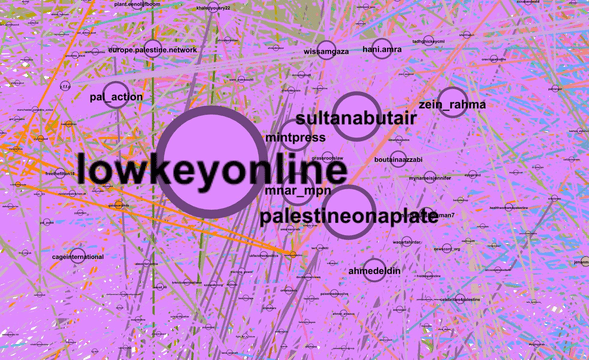
Figure 8: A zoomed-in view of Figure 7, focusing on the heart of the purple subnetwork.
Looking at Figure 8, most prominently we see lowkeyonline, the Instagram handle of the British-Palestine hip-hop artist. Close to his handle, and thus indicative of a strong coauthor relationship, we see mintpress, the Instagram handle of Mint Press News; and mnar_mpn, the Instagram handle of Mint Press News’ founder. The founder is also a trauma and nutrition coach, which perhaps explains why she sometimes coauthors with palestineonaplate, the account of a Palestinian activist and chef.
The most frequent coauthors of mintpress over the period of October 1, 2024 - January 31, 2025, are listed in descending order in Table 1.
| Coauthor of Mint Press News on Instagram | No. of co-authored posts |
|---|---|
| mnar_mpn | 222 |
| lowkeyonline | 157 |
| sultanabutair | 112 |
| grassrootslaw | 47 |
| palestineonaplate | 7 |
Table 1: Top coauthors of Mint Press News on Instagram, October 1, 2024 - January 31, 2025.
As noted above, mnar_mpn is the handle of the founder of Mint Press News, and she turns out to be its most frequent coauthor during the four-month study period. The second most frequent is lowkeyonline, followed by sultanabutair.
The majority of the British-Palestinian rapper’s coauthored posts with Mint Press News concern Palestine, consistent with the idea that people mobilized initially by the injustice they witness in Palestine can ultimately find themselves in league with conspiratorial outlets like Mint Press News. The minority of lowkeyonline’s coauthored posts with mintpress that pertain to Syria play upon the theme that the transitional government is friendly towards Israel, that Israel is attacking Syria while the transitional government does not retaliate, that Syrian rebels have long been in league with Israel, and so on.
Conclusion
The fall of the Assad dynasty is a cause for celebration and hope, but Syria’s future will depend on the delicate choreography of this transitional period. If history is any indication, how things are narrated through this time will matter as much or more as material developments. In this investigation of social media activity on Facebook and Instagram, we saw that voices from outside Syria with wide followings on the global left are very negative about Syria’s new government. Understandably outraged by Western complicity in apartheid and genocide in Palestine, they look upon Assad’s collapse with doubt, reading alliance and intrigue in what was plausibly just coincidence. As Israel profits from Syria’s defenselessness, the tendency will be to blame the transitional government, casting it as impotent at best, or Israel’s stooge at worst, and creating an opening for infighting. Meanwhile, the very real concerns about the treatment of minorities within the country can be played up, as rumors become allegations and allegations become convictions. With so much in flux and so much at stake, we may all feel the temptation to take action, one way or another. But perhaps the best advice at this time is to watch and listen and continue gathering data, and to suspend judgment.



